One of the things that has spurred interest in historical wargames over the past few years that goes beyond just becoming reacquainted with the hobby, has been the impact and the nexus of Technology, Strategy and Leadership, and titles that enable exploring that evolution.
Many of the first forays back into the hobby centered around Ancients warfare and the classic Great Battles of History system . Dozens of plays later, the game still impresses me and evokes a real sense of what happened and why in a consumable format. Those experiences quickly led to looking at other system based titles. TCS was one of the first to be explored. The Tactical Combat System explored a similar scale to GBoH but the experience was much different. Platoons of men and squadrons of tanks vie for control of a typically larger battle space, rather than the cohorts and phalanxes or bands of ancient warriors. The similarities of course end there.
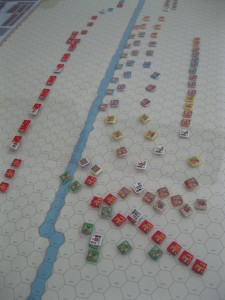
In Modern 20th Century warfare, technology has placed a bloody stamp upon how warfare is conducted. We all understand this basic premise for modern warfare; rate of fire times the number men with guns gives us a killing ratio that would drive a Macedonian insane if he saw the effects! How many times you can swing a sword or thrust a spear in a minute were meaningless in the face of 1 musket ball a minute across a 100 yard frontage or 600 rounds per minute from a single machine gun flying across a field at 744 m/s. The TCS system of WWII combat drove this bloody point home.
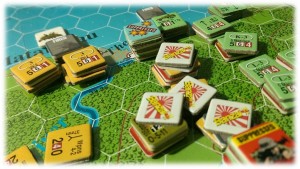
This concept of and use of massed fires evolved over time and came fruition during the Napoleonic era. He brought the power of the cannon, the Grand Battery and concentrated fire power to bear among other aspects to his generalship that changed forever how war was to be waged. Generals were quick to adopt the weapons and methods, yet the basic tactics changed very little from the days of Alexander. Line up, march forward and give them steel, after you had survived the cannonade.
Recent podcasts by Dan Carlin drove this home just the other day. “It had been thousands of years since warfare and weapons technology had really changed from ‘Classical Strategy‘ ” he said. Men with sword, shield, horse, pike, spear or bow; arrayed in lines or columns smashing into each other. So much so that Sun Tzu writings and Clausewitz’s, On War have much in common in terms of practical application of strategy in the classical era despite being written 2400 years apart.
Napoleon’s time was perhaps the inflection point for this to change. Better muskets, more powerful ballistic attributes enabled by rifling, larger and more effective cannons all led to higher kill ratios on the battle field per man hour of combat. More men in one place firing more powerful rounds than the enemy. Systems of war changed also. The composition and structure of armies changed as means of conscription were adopted that brought the masses of the population to arms. These largely untrained conscripts required different means to be managed and led. Napoleon and his counsel began to form a General Staff aimed at serving his needs, which would be adapted by the Prussians into a well oiled machine for running large armies in WWI and beyond.
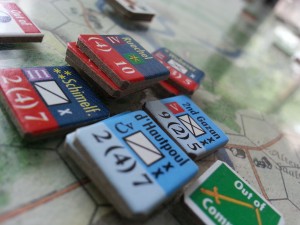
As leadership changed the strategy for bringing the enemy to that critical battle field and forcing a result also changed. Now self contained armies of thousands of men called Corps could roam the country in mutually supporting ways and corner the enemy. Strategy was evolving, but the tactics were slow to adjust, pin the center and flank were the common tactics used. No different from Alexander.
So this realization from reading history books created an interest in Napoleonic conflict that needed to be explored. Kevin Zucker from OSG first sated that curiosity and need at the Grand Tactical scale. While this scale clearly demonstrated the destructive firepower and some tactical elements of the eras conflict it and other systems from Multiman Publishing, Jours de Gloire and GMT games left a gap in the knowledge of the critical aspects of the movement to battle at a higher level, over the days preceding engagement. For this exploration OSG had its much neglected Days series of games.
The 5X, 2X and even 1X titles provide a clear sense of the dynamics that were evolving as armies and corps traversed the country seeking that pivotal battle or Clausewitz-ian center of gravity. Here one can see the Corp movements, manage supply, hunt down the enemy and use the relatively aged CRT based system to resolve the Napoleonic battle in abstract style.
We had left the Classical Era and entered the Operational Era of warfare or maneuver warfare. Yet while still in its nascent stages it seems the evolution of the Operational Art of War was stalled, stunted or languished for a time as the bright shiny things of new technology over took all of the Generals attentions during the 1800’s and early 1900’s. The rate of technological change combined with the industrial capacity to manufacture such weapons overwhelmed many nation states, who were left behind the weapons curve, and paupered from the effort. A true arms race evolved after the Franco Prussian War in 1870.
Trains, the Telegraph, carbines, the Maxim gun, Naval advances and on and on all cost money and took industrialization and skilled labor to create. Employing these weapons, faster and more efficiently became more important than any other consideration of strategy. The fact countries had avoided a world war for so long until 1914, and had not seeing just how devastating these new technologies meshed with pseudo post Napoleonic tactics would be, is a pity. While Empires had battled tribes and dominated them with new high rate of fire weapons, and cavalry charges ended in the Crimea, no one seemed to have learned the lessons offered from these experiences. No one paid heed to how a battalion of soldiers charging across open ground would fare against a dozen maxim guns. No one thought through the impact of 100 howitzers delivering a barrage on a line for 2 hours. This neglect ended up changing war from some fanciful noble endeavor to a living hell to be endured during WWI
Tactics still had a wholly ‘Classical’ feel to them. Masses of men would approach an objective and be mowed down by machine guns and artillery. Fortresses where built to protect borders only to be turned to cement dust and scraps of rebar as giant guns demolished them. WWI introduced the era of Industrialized killing. The perfect storm of rapidly evolving technology, calcified leadership principals wedded to strategy and tactics from a bygone era, woven into scientifically precise marching timetables and wrapped in classical tactics that Caesar would appreciate. Disaster for the attacker.
Is it any wonder that ones stomach churns at the thought of WWI titles? Leadership, tactics and strategy evolved so slowly that millions had to die before military theory and practice could catch up to the pace of technological innovation in death dealing machines.
Finally leaders worked it out. Tactics did changed, enemies adapted, and the mobility of the land based battleship or tank broke for ever the concept of coherent entrenched lines in a defense. Walls and trenches were no longer enough. This upheaval would of course cause the fall of empires and the decline of monarchy through out Europe.
The TCS system does a fantastic job (maybe too good) of demonstrating the difference in firepower, tactics and command. Mantanikau and GD ’42 are excellent examples of weapons placement, command planning, and tactical choices that were required to be successful on a World War 2 battlefield. The sickening death toll in the Pacific theatre titles is painful. Losses on both sides rack up alarmingly fast. So much so that entire companies can be blown away via Banzai charges, massive arty strikes or a melee that goes horribly wrong. Lower level tactical squad scale conflicts explored via ASL or Lock N’Load or Advance Tobruk System also provide some insight into the definitive tactical shift, away from lines and columns to the more highly dispersed, cover, suppress and approach or Find, Fix, Flank and Finish style of combat. Each system shows in its own way the different modes of combat, and the rewards for using modern best practices.
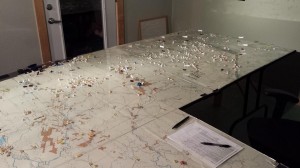
If TCS gave us a window into the ability of new technologies impact on the ability for man to kill, then OCS (Operational Combat System) allowed us to see how Operational Art of War emerged from the cesspool of WWI and became a driving force in future conflicts. In fact the very technologies that created such mayhem did not only drive theorists and strategists towards a non Classical style of war the very same technologies enabled it. Napoleons maneuver warfare was now a reality via trucks, tanks, rail and air. The blitzkrieg concept, the concept of momentum being equally if not more important that mass drove home the new reality of the importance of the center of gravity, or critical point when attempting to defeat an enemy in battle or war. Logistics, coordination and command drove military theory.
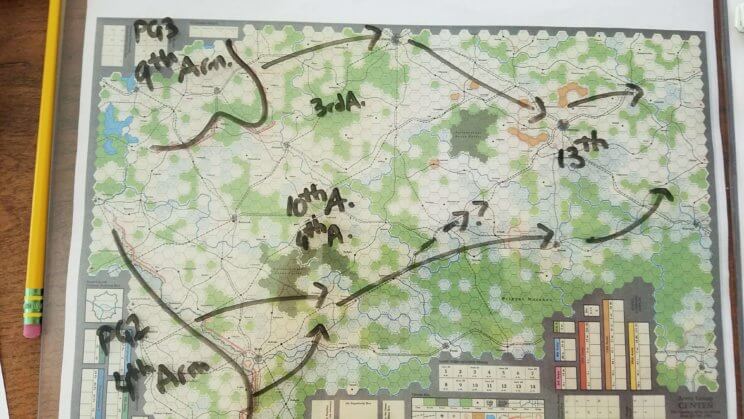
There are many other systems that enable these explorations of maneuver so many in fact that exploring them all is difficult. Eastern front titles of note include AGC, from 3W, A Victory Denied, Road to Leningrad, The Russian Campaign and even SPI titles such as Operation Star or GDW’s Red Army all bring concepts of the operational art of war to bear along with the technology of the era. Today the BigBoard library is brimming with titles that warrant the exploration of maneuver warfare and the Operational Art of War. Its a fabulous time to be a historical wargamer!
In more modern times after WWII the true fear of nuclear Armageddon muted the risk of global warfare. The race to the largest nuke however petered out, and the military complex looked to better, faster, more deadly and more effective means of dealing with the enemy at range and with increased lethality. Enter the era of localized mass destruction. Napalm, AC Gunships, Rocket systems, Jet aircraft, and precision guided munitions ..oh and massive CV’s!
To date modern warfare has comprised local in country affairs that became highly asymmetrical in nature [excluding Korea]; Vietnam, Israel vs Arab states, Angola, Algeria, Iraq, Afghanistan, Syria and the Ukraine. Technology and war fighting tactics have changed again and adaptation once again lags the technological evolution of weapons.
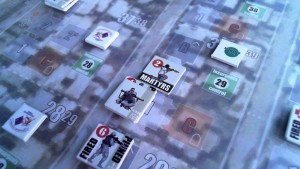
Suicide fighters, IED’s, attacks on the populace, terror tactics, Special Forces, Militia formations, drones, and distributed war-fighting are changing the landscape again. Today we have few ‘historical’ game systems that capture these modes of fighting accurately. Ici c’est la France! , Phantom Fury and the soon to be published Urban Operations come to mind as two topics attempting to explore the challenges. No doubt more are on the way.
We have few titles to explore in part because countries and, military leaders around the world struggle with the new nexus of technology evolution and strategy & tactics in the landscape foisted upon the leadership as a result of those advances. How the Super powers, and smaller countries deal with the evolution of tactics and strategy in the future will be fascinating to learn about and potentially explore on the cardboard and paper we use as a device to better understand the world of conflict.
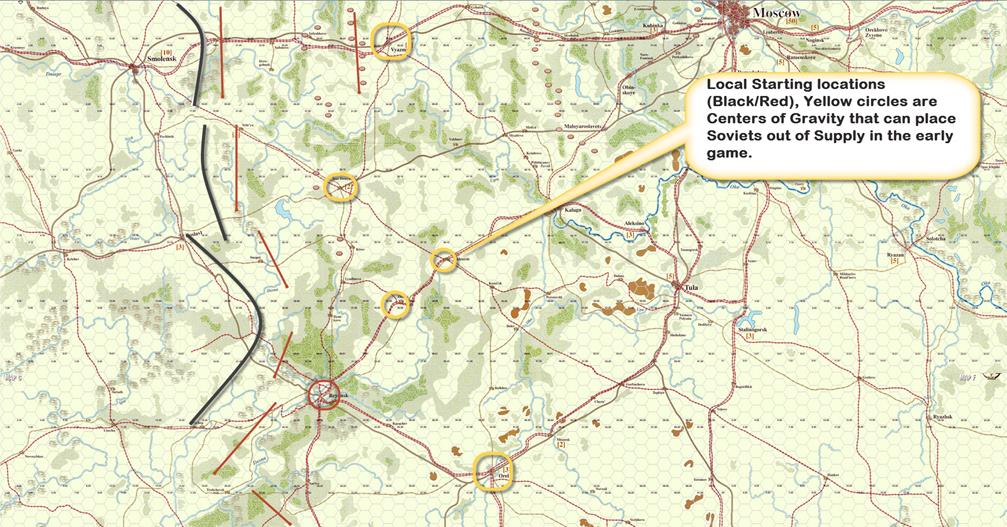
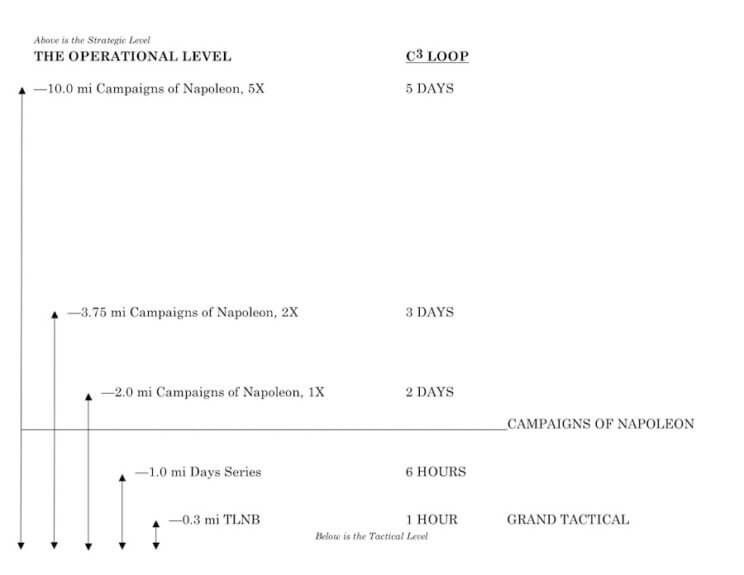
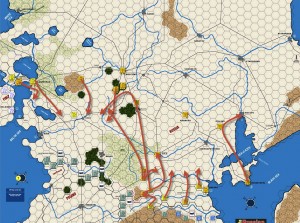
Ever think of teaching at a war college? Interesting evolution you describe and I believe you are you correct on why a game plays different in each era….that difference you describe is ultimately the secret sauce for gaining the advantage of winning in that game or era.
The closing paragraph is food for thought. I’m an engineer by trade and I was taught early on to sketch out the problem….if you can’t sketch it, then you don’t understand it. Do we understand could be conflicts that are possible today to accurately sketch them out into a game format? Or do we tell ourselves that to ease our fears over a real potential war scenario?
My fear in conflicts today that it’s a lot of small wars that are – get in and get out – rather than a true front….more like wack a mole. Our western based militaries are geared for that now and they are a bit one sided to a degree….are they ready for a massive 1 or 2 front war these days and what would that style of play look like? Even the supply chain is thin (manufacturing in China) so that the western military ability to stay in a protracted campaign is an issue (remember 3rd Reich game BRP’s – I would hate to see those numbers today).
You made me self reflect here on my war game hobbie and how they play or flow over history. I ultimately love the challenge and learning process. Thanks for keeping it alive!
Hey David. Thanks for the insightful comments. We all have a lot to learn.
Great post—thank you.
Two points:
1) Recently read an article on the design/build setbacks of the CVN Gerald R Ford. Critical systems that do not work or work reliably such as the electro-magnetic aircraft catapult system that may impair proper deployment of the carrier’s air group. Escalating costs, already breathtakingly high may reduce renewal of the fleet.
Agree/disagree? Important questions are raised, especially about a costly class of naval asset that may be a strategic liability (remembering the HMS Prince of Wales/HMS Repulse off of Singapore in 1941).
For those interested, the link is here http://warisboring.com/how-not-to-build-an-aircraft-carrier/
2) Read an article (10+ years ago) about a WWII vet who made a visit to Afghanistan to visit a grandson/great-grandson and was immediately struck about how few troops there were, compared to his time.
Is that part of the answer on the predictable failure of most NATO type COIN operations?
Terry
Great points. The future battle methods and tech are changing on commanders rapidly. We saw how many lives it cost to adjust during WW1.